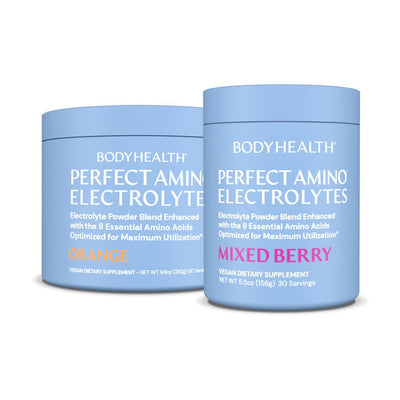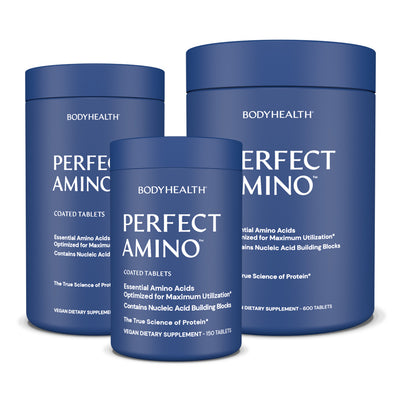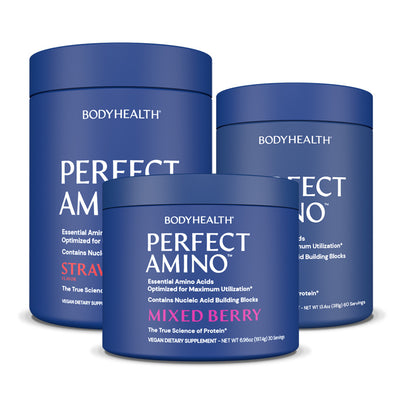How BCAAs Build Body Fat & Lower Health Over Time
by Dr David Minkoff March 19, 2024 7 min read

Those are some big claims in that title.
And how could they be true when we have statements like:
“BCAAs stimulate the building of protein in muscle and possibly reduce muscle breakdown.”
“Valine is needed for your muscle fibers to fire, for tissue repair, and for the maintenance of proper nitrogen balance in the body.”
“Leucine stimulates muscle protein synthesis and may be the dominant fuel involved in anabolic (tissue building) reactions.”
Well, unfortunately, the claims in the title of this article are true.
They come from research studies done on BCAAs, while the above quoted statements come from marketers.
BCAAs, or Branched Chain Amino Acids, taken on their own regularly and over time, can have a significant effect on body fat creation, muscle gain reduction, kidney trouble, type 2 diabetes, metabolic syndrome, and obesity.
And it's becoming quite a problem. Just google "BCAAs side effects" or "BCAAs and Type 2 Diabetes" and you'll find much more than you wanted to.
But how can they say these things and how does this all work?
Let's dig in and see.
HOW AMINO ACIDS ARE USED IN THE BODY
We know about protein and collagen and amino acids.
Proteins are composed of amino acids. And collagen is just one type of protein.
When we eat protein or collagen, in any form, our digestive system breaks it down into individual amino acids. Then our cells build these back up into new protein and collagen for muscle, skin, bone, hormones, etc.
But… there are specific amino acids our bodies use for this and aminos our bodies don’t.
These are called essential amino acids and non-essential amino acids.
Essential amino acids are the amino acids your body cannot make on its own, hence the word essential. Instead, we need to get them from outside food sources.
Non-essential amino acids are the amino acids your body can make on its own — when it has all of the essential amino acids.
But that’s the trick. It must have all of the essential amino acids at the same time in order to make each of the non-essential amino acids.
If it doesn’t, then it can’t make non-essential amino acids and it can’t make new proteins or collagen.
Not any. It’s physically impossible.
This is where you hear about complete proteins and incomplete proteins.
Complete proteins contain all of the essential amino acids. So your body can break them down, get all of the EAAs from them, and build new proteins and collagen from these.
Incomplete proteins only have some of the EAAs. So your body breaks them down into individual amino acids, but, as some of the EAAs are missing, your body can’t make any new protein from them.
This is why we have certain food combinations such as beans and rice. Individually, neither have all of the essential amino acids. But together they do. So our body can break them down, get all of the EAAs, and make new proteins.
BCAAs are an incomplete protein.
Well, they’re not a protein at all. They’re three of the EAAs.
So, when taken alone, they don’t give the body what it needs to make new protein, and so can’t be used.
They could be taken with other protein sources, but even here they would still mostly be in excess as most proteins are already high in BCAAs.
As our bodies need an exact ratio of each of the essential amino acids, if there are extra amino acids above this, such as BCAAs take with proteins, they are mostly in excess and can’t be used.
And that’s the problem.
UNUSED AMINO ACIDS ARE CONVERTED TO SUGAR OR BODY FAT
Your body doesn’t just need all of the essential amino acids to build new protein and collagen. It needs them all at the same time.
You see, both fat and sugar (carbohydrates) can be stored by the body so they can be used later on. They’re stored as body fat or as glycogen (stored chains of sugar).
But our body has no way to store amino acids. They’re in the blood stream for about 2-3 hours. If they’re not used in that time, they go through a process called gluconeogenesis.
This is where the amino acids themselves are broken down, or deaminated. From here they’re converted into sugar, fat, or other energy forms.
These are the actual calories in any protein source. The amino acids that weren’t used to build new protein, but were converted to sugar or fat.
So when we consume BCAAs, which are only three of the essential amino acids, our body can’t do anything but convert them to energy. That’s what you feel in the gym when you take them — a sugar rush.
You may as well have eaten a candy bar. At least the candy bar can be immediately broken down into sugar.
BCAAs can’t. They first need to be broken down in the liver before being converted into sugar.
But breaking down amino acids also releases nitrogen waste and ammonia.
This is fine, it happens all the time, but with natural proteins it happens much less.
With natural proteins only part of them have to be broken down in the body.
But with BCAAs it’s almost all of them.
When taken often, this creates quite a bit of strain on our liver and kidneys.
This is that ammonia smell some people have when they sweat or in their urine — too many unused amino acids overloading their liver and kidneys.
This is also where the idea that too much protein is toxic comes from.
Protein, or amino acids, aren’t toxic.
Amino acids that weren’t used to make new protein, but were instead broken down, releasing too much extra nitrogen that strains the liver and kidneys… those are toxic.
WHY DO PEOPLE THINK BCAAS HELP THEM?
Good marketing. That’s the first reason.
Many influencers these days will promote many things for the right amount of money, even if they don’t use the products themselves.
We know. We get the offers. Which is why we only allow someone to be an influencer if they are already actively using PerfectAmino. Good marketing has to be real.
But it’s the claims which are tied to the individual amino acids themselves that make BCAAs look so attractive:
“BCAAs stimulate the building of protein in muscle and possibly reduce muscle breakdown.” Yes, when the other EAAs are present.
“Valine is needed for your muscle fibers to fire, for tissue repair, and for the maintenance of proper nitrogen balance in the body.” And it does this — when the other EAAs are present.
“Leucine stimulates muscle protein synthesis and may be the dominant fuel involved in anabolic (tissue building) reactions.”
“Isoleucine is essential for blood sugar regulation, muscle development and repair, and energy regulation.”
This sounds great and I could go on.
Because all of it is true… if your body receives all of the essential amino acids at the same time.
Does that make sense?
You need the BCAAs for sure. But unless they’re combined with each of the other essential amino acids, they’ll just be converted to sugar or body fat.
THE SIDE EFFECTS OF BCAAs OVER TIME
Over time this really does put a strain on your body.
Plus, this added sugar raises cortisol levels, a hormone that prioritizes the building of body fat and breaking down of muscle, and can cause insulin resistance.
So over time you have to work harder to build muscle and keep body fat levels low.
And you need new tricks to do so. More powerful pre-workouts that are very hard on the kidneys, insulin injections and straight glucose (unneeded in a healthy, functioning body), steroids, and even chemicals to enlarge the muscle tissues they’re injected into.
So while marketing has associated BCAAs with muscle growth, recovery and other effects, time has now associated them with insulin resistance, type 2 diabetes, obesity, and metabolic syndrome.
In fact, there is actually no study published that states that BCAAs taken on their own help increase muscle or recovery. Just marketing copy.
But I won’t get into all of that. A simple search of “BCAAs side-effects” or "BCAAs and type 2 diabetes" will give you much more than you wanted to know.
And it doesn’t matter anyways. Because you don’t need them. They don’t help you, not on their own.
You need all of the essential amino acids and you need them in the correct ratio for the best results.
That's what PerfectAmino is.
Even more, it’s the essential amino acids in the exact ratio one to another needed by the body for up to 99% utilization in building new protein and collagen — over twice the utilization of the highest natural protein source: whole eggs.
Meaning, even 5 grams of PerfectAmino produce less than 1 calorie in the body, while building as much protein in the body as two eggs, or 30 grams of whey (a much lower utilized protein source).
And, PerfectAmino, unless taken in the most extreme excess, not only puts no strain on the liver or kidneys, but helps to repair tissue for improved function.
On the Lean Body/Lean Bulk Protocol we don’t take any BCAAs or individual amino acids.
And we don’t need to.
Because it’s pretty amazing what can happen when we just give the body what it actually needs.
If you haven’t seen the Lean Body/Lean Bulk Program, check it out and do the 30-Day Challenge. It’s very effective.
And make sure to join our VIP Group where you can ask any question you have and get only the best answers.
Index To The Lean Body/Lean Bulk Guide:
Introductory Articles:
Getting Started:
- The Lean Body/Lean Bulk Guide & 30-Day Challenge
- Hormones: The Third Dimension of Calorie Cutting
- The Lean Body/Lean Bulk Diet
Supplements & Macros By Goal:
- Supplements & Macros For Lean Body
- Supplements & Macros For Beginner To Moderate Lean Bulking
- Supplements & Macros For Advanced Lean Bulking
Workout Regimens & Exercise Videos:
- Beginner to Moderate Level Workout Regimen
- Advanced Workout Regimen
- Lean Body/Lean Bulk Exercise Videos
Week One:
- Metrics & Key Data For Week One
- How BCAAs Build Body Fat & Lower Health Over Time
- The Importance Of Complete Protein Digestion
Week Two:
- Dialing In Our Macros For Lean Muscle: Hormones & Cravings
- How Cortisol Breaks Down Muscle & Prevents Protein Synthesis
- How To Improve Growth Hormone, Testosterone & Protein Synthesis
Week Three:
Articles by Health Topic
Get “The Search for the Perfect Protein”
by Dr. David Minkoff
Signup for the BodyHealth Newsletter and get a FREE digital copy of "The Search for the Perfect Protien" by Dr. David Minkoff and discover the key to weight loss, depression, fatigue, insomnia, and osteoporosis!
*These statements have not been evaluated by the Food and Drug Administration. These products are not intended to diagnose, treat, cure, or prevent any disease.



